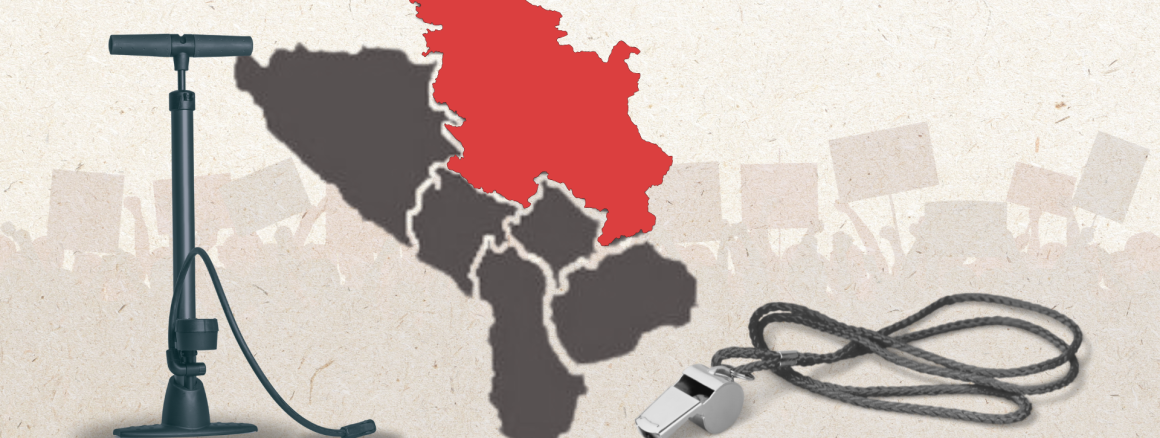Regional media reporting on months-long student-led protests in Serbia
March 14, 2025
Novi Sad train station canopy collapsed on November 1st, 2024, killing fifteen people, and severely injuring two more. This ignited a nationwide, student-led movement in Serbia, demanding justice for victims and the rule of law. Since the protests began, RDN has closely followed how Serbian media have covered them. As students are currently marching from all parts of the country towards Belgrade for a huge protest tomorrow, we present our regional analysis of media reporting on the protests so far.
As the protests gained momentum, media across the region provided extensive and in-depth coverage of the movement. Generally, reporting was professional and credible, with most outlets portraying the protests authentically. This topic gained coverage across media with large audiences, such as media with national coverage and popular portals.
In North Macedonia, the protests were largely framed as student-led, with the four main demands clearly communicated to the public. However, many outlets provided the same space for statements from high-rank public officials such as Serbian President Aleksandar Vučić, that often include harmful rhetoric, targeting and discrediting students and citizens who support them. A similar trend was observed in Montenegro, where certain media repeated narratives coming from pro-regime Serbian outlets and government representatives, who frequently labeled the protests as a ‘color revolution’. Some of the most common media narratives based on manipulations and spin had a spill-over effect from Serbian tabloids and pro-regime media to other countries in the region. For example, in North Macedonia, some media also adopted the ‘color revolution’ framing of the protests.
Despite Serbian pro-regime media pushing disinformation that the protests were influenced by Albania, Albanian media covered the movement in a detailed and professional manner. Serbian tabloids claimed the protests were backed by Western powers and their ‘regional satellites’ Croatia and Albania, portraying these countries as ‘enemies of Serbia and the Serbian people’. While most Albanian media depicted the protests authentically, some also shared unfounded claims on the supposed Russian and Chinese influence on the movement. However, such claims remained marginal. In-depth articles analysing the protests’ root causes dominated the discourse, with the movement primarily framed as a broad, unified stand against the Serbian government. However, students in Serbia consistently emphasised that their demands were directed at institutions, regardless of which government was in power. While Serbian and regional media often framed the protests as strictly anti-government, students communicated their fight as a fight against systemic corruption. A similar case was noted in Bosnia and Herzegovina, when a widely read portal, Klix.ba, reported that students were protesting “against the ruling SNS party and Serbian President Aleksandar Vučić.”
Beyond this case, other major outlets in Bosnia and Herzegovina, such as Mostar-based portal Bljesak and portal Nezavisne in Banja Luka reported objectively and professionally, listing all student demands and portraying protests credibly. Klix.ba had reporters on the ground during the February 1st protest in Novi Sad, when students blocked all three city bridges. In its coverage, this portal quoted students expressing dissatisfaction with authorities’ response to the station canopy collapse and their belief that those responsible had not been properly prosecuted.
Kosovo media have reported on the protests professionally since the beginning, though without daily updates. National outlets covered major demonstrations and key events, but Kosovo’s parliamentary elections in February remained their primary focus. The protests were presented as student-led, with the four key demands clearly communicated – the publication of the complete documentation on the reconstruction of the Novi Sad train station, the dismissal of criminal charges against students and youth arrested and detained during protests, filing criminal charges and prosecuting attackers of students and professors and a budget increase for higher education.
As mentioned, some Montenegrin media outlets transmitted harmful messages from Serbian public officials. Furthermore, harmful narratives found in Serbian pro-regime media were amplified through certain outlets in Montenegro. For instance, portals Borba and IN4S mirrored Serbian tabloid rhetoric, discrediting students, and falsely presenting opposition politician Dragan Đilas as the leader of the protests. This disinformation was based on a fake video that circulated in Serbian tabloids. However, national media with a large audience such as the public broadcaster Radio and Television of Montenegro (RTCG), Vijesti and popular portal CDM reported objectively and professionally.
The protests have gained broad support across the region, with students often portrayed as symbols of hope, challenging outdated, corrupt, and ineffective political systems. However, while there has been regional solidarity, social media discourse remains sporadic, as national issues continue to dominate public attention. This is especially true in Kosovo, where elections remain in focus. Additionally, strong political polarisation in Serbian society and media occasionally crosses over to the neighboring countries, especially in regions with significant Serb population. Consequently, in Bosnia and Herzegovina, protest-related social media discussions included a mix of support and hostility. In Facebook comment sections, students were alternately called a “sect” and “scumbags,” while others expressed support to their cause.
Media across the region generally reported on the protests professionally, though harmful narratives pushed by pro-regime media in Serbia somewhat influenced regional coverage on the student blockades and citizen protest. Despite occasional spillover of disinformation and media manipulations from Serbian mainstream media, student demands and the broader systemic issues they highlight were heard and seen throughout the region.
